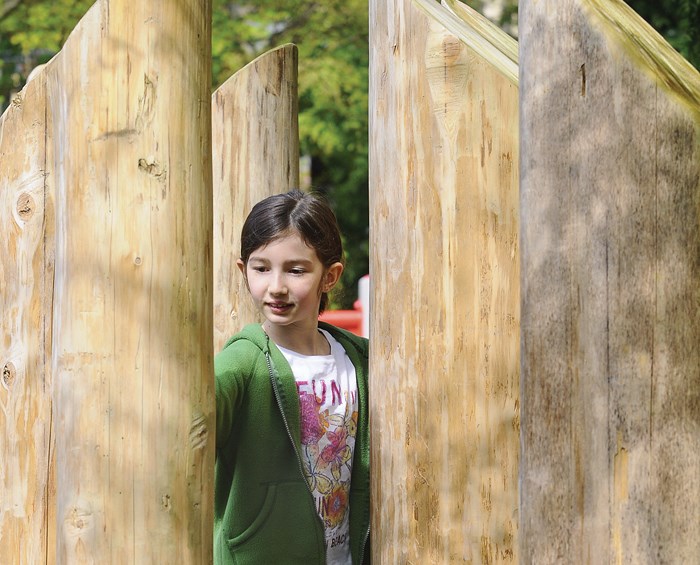I can hear their gleeful sounds as they run across the pea gravel, each healthy footstep punctuated by laughter.
These are some of the sounds you will hear from children playing in spaces built for fun and exploration. Each experience a child has in challenging play areas helps build their sense of confidence and joy in the outdoors. To build a garden for kids you have to watch and learn how they play. They often experience the living world by wandering about to see what's what. Or they touch as they go to get a sense of the world. And children often create their own make believe worlds or play scenarios in reaction to the type of play areas they experience.
For many city-dwelling children, the community playground or park is the only outdoor play area they may experience. Having built and upgraded community parks and playgrounds I can tell you that modern playgrounds are, shall we say "sanitized" to some extent. Not necessarily a bad thing where safety is concerned but modern playgrounds designed by adults limit play experiences.
I managed the design and construction of the playground that sits in a park directly across from my house and by virtue of proximity I can occasionally watch as parents and children experience the playground. It always surprises me how children will find interest in unintended things. For example, those round plastic footstep pods suspended by steel poles mounted with chain on the bottom that are meant for walking on, children like to bang them together with their hands simply to hear the noise. It is also interesting to note that the age appropriate ratings assigned to various playground styles are mostly unnecessary. Children younger than the structure's age rating will play up to the structure, children who are older than the age rating will usually play down to the structure.
I am not against building the traditional modern playground found in our parks, which are fun to a point and suit many uses, but something new is needed to captivate children's play. And it may be the growing movement to build naturebased playgrounds for public and private use.
The natural playground is easier to build in private residences where parents have direct authority over the activities of their children.
Natural playgrounds contain features found in nature that are modified or sanitized to provide play and learning experiences for children. Take, for example, the mud pit, hated by some parents as being too dirty and admonished by some officials as being unhygienic, it has been rethought and made into a mud barrel in the natural playground. The mud barrel is made from plastic and is situated near a sensor-controlled water source, because what's mud without water.
Trees are also rethought in the natural playground to provide opportunities for children to play. The larger trees are used to provide some shade, something missing from many playgrounds. Smaller trees can be placed to soften undesirable views. Proper tree species selection also allows the use of smallgrowing but well-branched trees for climbing. Some trees can be chosen to provide hiding places and visual barriers to be explored.
And all those old logs we use to cut up for firewood are now piled, planted, stacked and placed for log walking or climbing in the natural playground. Another great rethink creates rolling hills covered with grass and trees to allow kids to run, roll and chase around on. Even the common boxwood hedge can be repurposed to make small mazes, castle-like enclosures and directional barriers.
We should never underestimate the effect that flower and foliage colour has on a child's psyche. Bright cheerful daisies make adults happy and children too. The great variety of green leaves found on plants has a calming effect on parents and children alike. Plant fragrance is also an important natural experience that children respond to. Simple plants like lavender, sage or scented hardy geraniums can easily be incorporated into planted sections of natural playgrounds to provide interesting sensory experiences.
Playgrounds built with nature-based features like trees to climb on, water to play in and mud to wallow in appeal to the widest age range of children and cost less to build than modern playgrounds. Ultimately, adults should ask children what features they would like to play on before designing any play space. Even the craziest idea from a young mind can be made safe and possible with some creative thought and planning.
I feel that the expensive modern playgrounds I was responsible for building provide less than half of the imagination potential and fun benefit than that of a small pond with frogs, some logs to walk, a mud wallow and some trees to climb.
Todd Major is a journeyman horticulturist, garden designer and builder, teacher, skills trainer and organic advocate. For advice contact him at [email protected].



